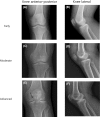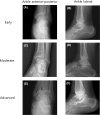A Combined Ultrasonographic and Conventional Radiographic Assessment of Hemophilic Arthropathy
- PMID: 28824241
- PMCID: PMC5544627
- DOI: 10.1007/s12288-016-0717-4
A Combined Ultrasonographic and Conventional Radiographic Assessment of Hemophilic Arthropathy
Abstract
Hemophilic arthropathy (HA) can be diagnosed by a number of imaging studies. However, it is difficult with conventional radiography to find soft tissue structures around joints, and ultrasonography has limited effectiveness in evaluating internal bony structures. We attempt to determine whether a combination of ultrasonography for soft tissue around joints and conventional radiography for bony structures can be used as a cost-effective imaging tool for evaluating HA and whether it reflects the functional status of hemophilic patients. Thirty-six males (median age 16.5 years; severe 34, mild 2) with hemophilia were recruited. We evaluated the severity of HA using combined imaging score that consisted of modified Petterson X-ray score (mPXS) and the modified ultrasonographic score (mUS). Joint impairment was clinically assesses using the World Federation of Hemophilia-Physical Examination (WFH-PE) scale and the Hemophilic joint health score (HJHS). We assessed the Hemophilia activities list (HAL) for the functional level. We performed a comparative analysis between the combined imaging score and the joint impairment scores as well as the functional scores. The mean mUS was 4.97 ± 3.99 points, and the mean mPXS was 2.85 ± 2.91 points; the combined imaging score was 7.83 ± 6.31 points. The combined imaging score was significantly correlated with the HJHS (p = 0.006) and WFH-PE scores (p = 0.019) as well as the HAL score (p = 0.002). A combination of conventional radiological and ultrasongraphic study might ultimately impact the optimal evaluation of joint impairment and functional status in hemophilic patients.
Keywords: Arthropathy; Function; Hemophilia; Musculoskeletal; Radiography; Ultrasonography.
Conflict of interest statement
Jae-Hyung Kim has received research Grants from Eulji University (No. 2013-EMBRI-DJ0003).
Figures




References
-
- Keen HI, Wakefield RJ, Grainger AJ, Hensor EM, Emery P, Conaghan PG. Can ultrasonography improve on radiographic assessment in osteoarthritis of the hands? A comparison between radiographic and ultrasonographic detected pathology. Ann Rheum Dis. 2008;67(8):1116–1120. doi: 10.1136/ard.2007.079483. - DOI - PubMed
LinkOut - more resources
Full Text Sources
Other Literature Sources
